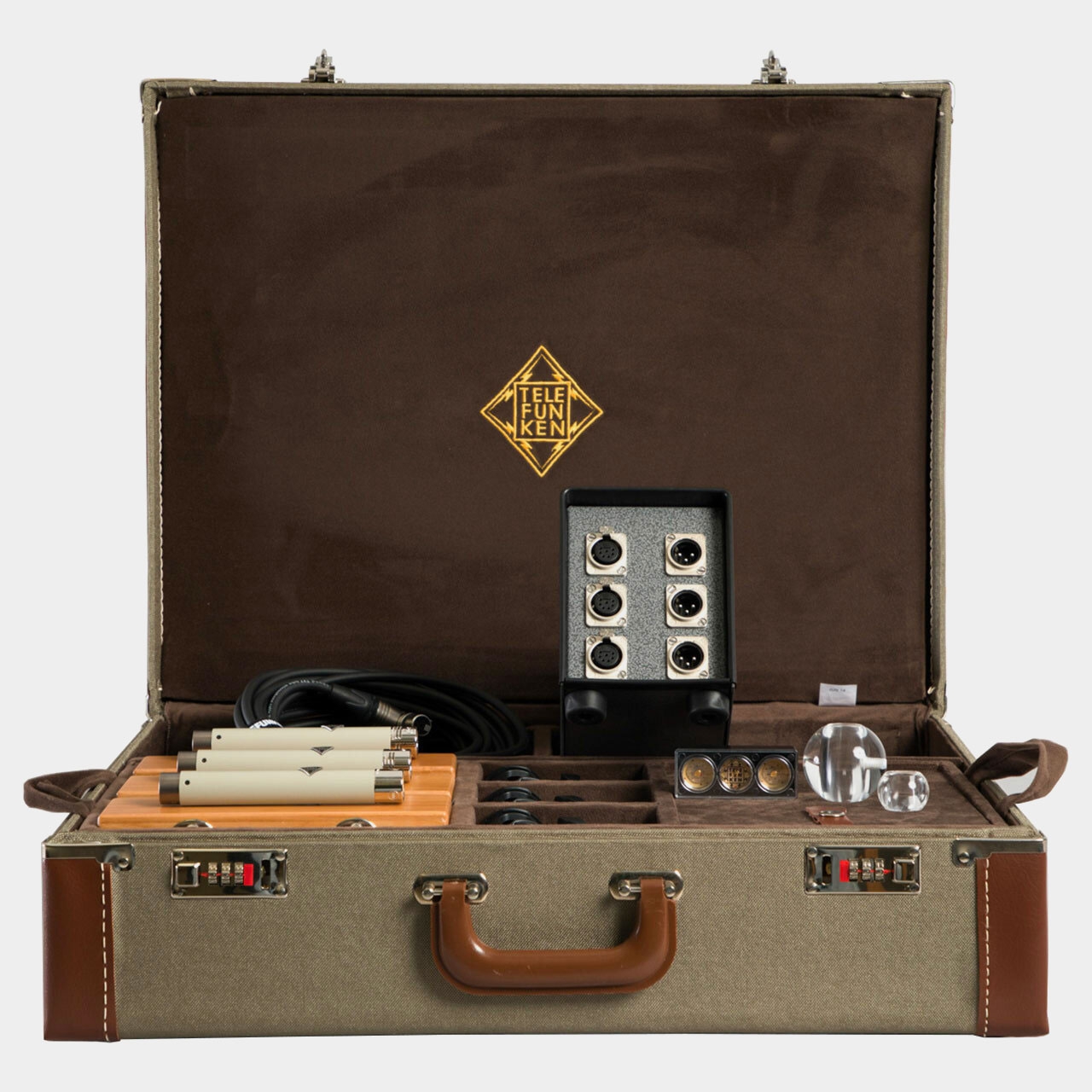


Telefunken ELA M260 Tri-Mono Set
£4,295.00 (Inc VAT)
£3,579.17 (Ex VAT). Shipping calculated at checkout.



£4,295.00 (Inc VAT)
£3,579.17 (Ex VAT). Shipping calculated at checkout.
If you work in film scoring or classical recording, then you should know what a Decca Tree is. If you don`t work in those disciplines, here is a brief synopsis of the Decca Tree [or "Tri-Mono"] recording technique.
Engineers who recorded classical music for Decca Records pioneered this microphone placement technique in the early 1950s when they wanted a strong sense of stereo image and balanced coverage of an orchestra, as the conductor might have heard while he led the orchestra.
The technique features three omni-directional microphones placed in a reverse "T" configuration, roughly above the head of the conductor. The "left" and "right" are positioned behind the conductor while the "center" microphone hangs in front of the conductor.
In addition to orchestral recording applications, the Decca Tree configuration can be an invaluable component to more contemporary recordings for drum applications and to gain an overall "band in a room" kind of atmosphere to your recording process.
The most common Decca Tree setup employs 3x 1-meter bars from which the microphones hang in a triangle configuration; though larger and smaller bar sets can be used.
The microphone most commonly employed for this technique is the Neumann M-50, though other microphones like the Neumann KM-53`s and Schoeps M-221b microphones have been successfully employed.
One of the problems often associated with the application of the Decca Tree technique is a loss of high frequency content due to the physics of how sound travels. The greater the distance a sound has to travel, the more high frequency information is lost due to the resistance of the air through which the sound must travel. Another problem that can be associated with this technique can be the capture of greater reverberant information than is often desired (due to the omni-directional capsules employed).
The capsule assembly of the Neumann M-50 featured a 40mm acrylic sphere which was actually a "diffuse field sphere" built into the M-50`s capsule assembly. In order to obtain a best of both worlds scenario, TELEFUNKEN Elektroakustik has created diffuse field spheres as an accessory for the ELA M 260 Tri-Mono Recording Set.
The addition of a diffuse field sphere is the most organic way to combat both effects; reducing the loss of high frequencies as well as minimizing the reverberant information. TELEFUNKEN Elektroakustik has made two different sized diffuse field-recording spheres available for the ELA M 260 series of microphones: 50mm and 30mm. The sphere is an accessory that attaches to the capsule end of the microphone, which effectively makes the microphone`s diaphragm part of the sphere as the sphere changes the shape of the transduction capsule. The result is a gradual and smooth rise in upper midrange and high frequency information captured by the microphone.
The sphere increases the directionality of an omni-directional capsule by altering the acoustic surface area of the capsule to nearly infinite. Where an omni-directional microphone has (for all intents and purposes) 360° pickup capability, with the addition of a sphere, the frequency response of the microphone is increased in the 2 - 10kHz region of the audio by as much as 2.5 db in the front of the microphone (50mm sphere) while being simultaneously diminished by about 2.5db from 5kHz up from the rear of the microphone. The 35mm attachment gives a less pronounced effect, which may be preferable for smaller venues.
This high frequency increase in the front of the microphone coupled with the decrease of upper frequency information from the rear of the microphone increases the perceived directionality of the microphone, while information coming from 90° and 270° remains unaffected. This increased directivity of the microphone, coupled with the rise in high frequency information permits better pickup at a greater distance from the sound source.
The TELEFUNKEN Elektroakustik TRI-MONO package for the ELA M 260 system consists of three ELA M 260 microphones [finished in black], a 3-channel power supply capable of powering all three microphones, three elastic shock mounts, and a set of three 10-meter AccuSound TX-7 tube mic cables with right angle XLR connectors. In order to foster an element of creativity, all three capsule systems [TK60 cardioid, TK61 omni-directional, and TK62 hyper-cardioid] are included in the package, along with a set of three 50mm and a set of three 30mm diffuse field spheres.
UK Mainland – Orders over £99 qualify for FREE standard shipping (1-3 working days) We also offer a range of chargeable express shipping options for next working day, pre 12pm, pre 10.30am, Saturday deliveries and deliveries on a specific date. Our main UK courier is DPD.
UK Non Mainland – Not eligible for free shipping. These areas include (but are not limited to) Isle of Man, Isle of Wight, Isles of Scilly, Jersey, Guernsey, Northern Ireland, Orkney, Scottish Highlands and Shetland. Shipping costs for these ares will be calculated at checkout.
International/Export – Delivery charges will be calculated at checkout. All orders that are in stock we aim to dispatch from our warehouse within 48 hours. We ship all orders outside of the UK, NI, Isle of Man, Channel Islands via Fedex. All prices and delivery charges are exclusive of VAT for export. The customer is responsible to pay for any additional duties and charges.
Read more on our shipping information page
If you have an SX Pro account:
Login, go to your Order History find the invoice for the item you want to return, click on the invoice then select “Request a return”, then select the item and quantity you want to return. This will take you to the returns form, simply fill it in and wait for our response.
No account, or orders prior to 31/03/2021
Simply fill out the returns form on this page and wait for our response.